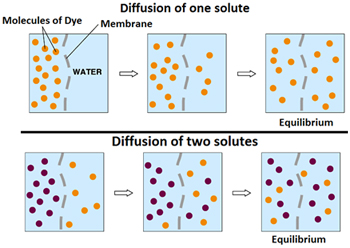Diffusion is the movement of molecules from a region of higher concentration to one of lower concentration. The net movement of the molecules is away from the region of high concentration to the region of low concentration.

Every cell exists in a liquid environment. One of the most important functions of the cell membrane is to keep the cell's internal conditions relatively constant, or maintain homeostasis. It does this by regulating the movement of molecules from one side of the membrane to the other. Approximate equilibrium is reached when the number of molecules inside the cell is equal to the number of water molecules that leave the cell. Molecules are constantly moving so a true state of equilibrium is never fully reached. Molecules will just move back and forth equally.
There are several processes involved in moving materials across the cell membrane. These processes can be classified as either passive transport or active transport. First, let's look at passive transport.
Passive transport is the movement of a substance across a cell membrane without the input of the cell's energy. Passive transport moves substances from an area of high concentration to an area of low concentration, so the cell does not need to spend energy.
There are three types of passive transport: diffusion, facilitated diffusion, and osmosis.
|
Diffusion is the movement of molecules from a region of higher concentration to one of lower concentration. The net movement of the molecules is away from the region of high concentration to the region of low concentration. |
 |